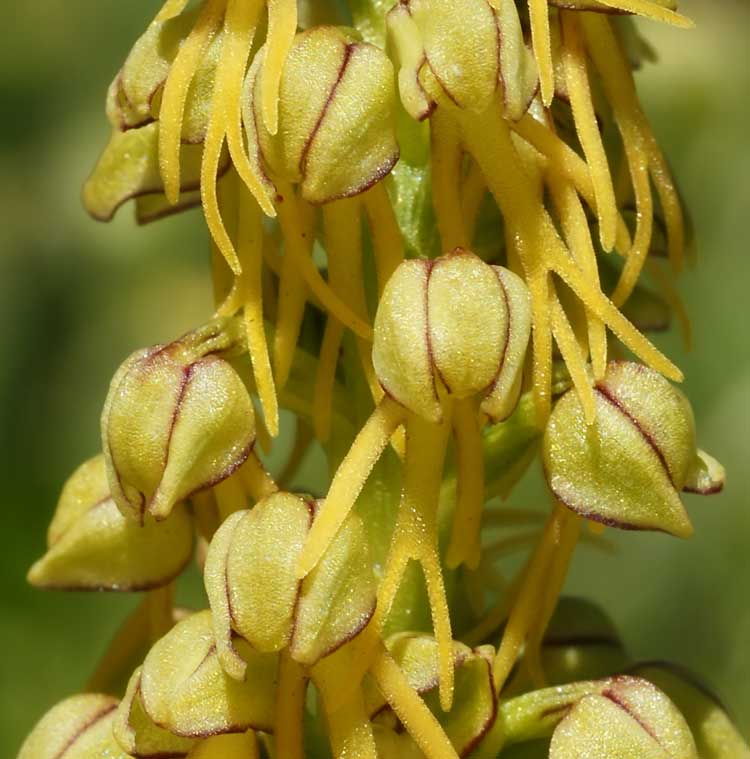
Orchis anthropophora (*)
Classification System: APG IV
Superregnum: Eukaryota
Regnum: Plantae
Cladus: Angiosperms
Cladus: Monocots
Ordo: Asparagales
Familia: Orchidaceae
Subfamilia: Orchidoideae
Tribus: Orchideae
Subtribus: Orchidinae
Genus: Orchis
Subgenus: Orchis subg. Orchis
Sectio: Orchis sect. Anthropophorae
Species: Orchis anthropophora
Name
Orchis anthropophora (L.) All., Fl. Pedem. 2: 148 (1785)
Synonymy
Basionym
Ophrys anthropophora L., Sp. Pl.: 948 (1753)
Homotypic
Arachnites anthropophorus (L.) F.W.Schmidt, Fl. Boëm. 1: 77 (1793)
Satyrium anthropophorum (L.) Pers., Syn. Pl. 2: 507 (1807)
Aceras anthropophorum (L.) R.Br. in W.T.Aiton, Epit. Hortus Kew.: 281 (1814)
Loroglossum anthropophorum (L.) Rich., De Orchid. Eur.: 32 (1817)
Himantoglossum anthropophorum (L.) Spreng., Syst. Veg. 3: 694 (1826)
Serapias anthropophora (L.) Jundz., Opisan. Rósl.: 267 (1830)
Heterotypic
Ophrys anthropomorpha Willd., Sp. Pl. 4: 63 (1805)
Satyrium anthropomorphum Pers., Syn. Pl. 2: 507 (1807), orth. var.
Loroglossum brachyglotte Rich., De Orchid. Eur.: 32 (1817)
Aceras anthropomorphum (Pers.) Sm. in A.Rees, Cycl. 39(1): Aceras n. 2 (1818)
Aceras anthropophorum lusus flavescens W.Zimm. ex Asch. & Graebn., Syn. Mitteleur. Fl. 3: 783 (1907)
Aceras anthropophorum var. angustatum Rouy in G.Rouy & J.Foucaud, Fl. France 13: 181 (1912)
Aceras anthropophorum var. latior Rouy in G.Rouy & J.Foucaud, Fl. France 13: 181 (1912)
Aceras anthropophorum f. apiculatum Höppner, Verh. Naturhist. Vereines Preuss. Rheinl. Westphalens 81: 265 (1924 publ. 1925)
Aceras anthropophorum f. angustatum (Rouy) Maire, in Fl. Afr. Nord 6: 332 (1959 publ. 1960)
Aceras anthropophorum f. latior (Rouy) Maire, in Fl. Afr. Nord 6: 332 (1959 publ. 1960)
Aceras anthropophorum f. purpurata Balayer, Bull. Soc. Bot. France, Lett. Bot. 133(3): 280 (1986)
Distribution
Native distribution areas:
Europe
Northern Europe
Great Britain.
Middle Europe
Austria, Belgium, Germany, Netherlands, Switzerland.
Southwestern Europe
Baleares, Corse, France, Portugal, Sardegna, Spain.
Southeastern Europe
Albania, Greece, Italy, Kriti, Sicilia, Yugoslavia.
Africa
Northern Africa
Algeria, Morocco, Tunisia.
Asia-Temperate
Western Asia
Cyprus, East Aegean Islands, Lebanon-Syria, Turkey.
References: Brummitt, R.K. 2001. TDWG – World Geographical Scheme for Recording Plant Distributions, 2nd Edition
References
Primary references
Allioni, C. 1785. Flora Pedemontana 2: 148.
Kretzschmar, H., Eccarius, W. & Dietrich, H. 2007. Die Orchideengattungen Anacamptis, Orchis, Neotinea. EchinoMedia-Verlag, Bürgel. Table of contents. ISBN 978-3937-10711-0. Reference page.
Links
Govaerts, R. et al. 2019. Orchis anthropophora in Kew Science Plants of the World online. The Board of Trustees of the Royal Botanic Gardens, Kew. Published online. Accessed: 2019 August 12. Reference page.
Govaerts, R. et al. 2019. Orchis anthropophora in World Checklist of Selected Plant Families. The Board of Trustees of the Royal Botanic Gardens, Kew. Published online. Accessed: 2019 August 12. Reference page.
International Plant Names Index. 2019. Orchis anthropophora. Published online. Accessed: 12 August 2019.
The Plant List 2013. Orchis anthropophora in The Plant List Version 1.1. Published online. Accessed: 2019 August 12.
Tropicos.org 2019. Orchis anthropophora. Missouri Botanical Garden. Published online. Accessed: 12 August 2019.
Vernacular names
català: Flor de l'home penjat
Deutsch: Ohnhorn
English: Man orchid
español: Orquídea hombre
français: Homme pendu
hornjoserbsce: Mužikowa bjezwotrožka
italiano: Ballerina
lietuvių: Šlaitinis beragis
Nederlands: Poppenorchis
svenska: Spökyxne
中文: 人帽兰
Orchis anthropophora (formerly Aceras anthropophorum), the man orchid,[2] is a European species of orchid whose flowers resemble a human figure. The head is formed by the petals and sepals, and the suspended torso and limbs by the lobes of the labellum. It usually grows in calcareous grassland.
Description
The man orchid is a herbaceous perennial, growing to a height of 20 to 40 cm (7.9 to 16 in). A basal rosette of 5 cm (2.0 in) lanceolate leaves develops from a tuber 6 cm (2.4 in) in diameter, and between April and June a central flower spike is produced bearing up to fifty small, stemless flowers – the flowers vary from greenish, with a yellow-green labellum, to green, streaked and marked with purple.
Leaf rosette before flowering
Aceras anthropophora (detail).jpg
Habitat
Orchis anthropophora favours moderately sunny meadows on well-drained, often calcareous soil. It is to be found around the Mediterranean area, and in central and western Europe as far north as southern England. It also grows in alpine areas, but not at high altitude.
It is native to Great Britain, central Europe (Austria, Belgium, Germany, the Netherlands, and Switzerland), southwestern Europe (the Balearic Islands, Corsica, France, Portugal, Sardinia, and Spain), southeastern Europe (Albania, Greece, Italy, Crete, Sicily, and countries of the former Yugoslavia), northern Africa (Algeria, Morocco, and Tunisia), and western Asia (Cyprus, East Aegean Islands, Lebanon, Syria, and Turkey).[1]
See also
Naked man orchid
References
"Orchis anthropophora". World Checklist of Selected Plant Families. Royal Botanic Gardens, Kew. Retrieved 2014-06-30.
BSBI List 2007 (xls). Botanical Society of Britain and Ireland. Archived from the original (xls) on 2015-06-26. Retrieved 2014-10-17.
Retrieved from "http://en.wikipedia.org/"
All text is available under the terms of the GNU Free Documentation License

